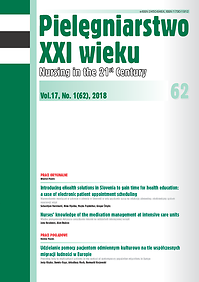Neutropenia in adults – significant diagnostic issue
DOI:
https://doi.org/10.2478/pielxxiw-2018-0006Keywords:
neutropenia, neutrophils, agranulocytosis, febrile neutropenia, drug-induced neutropeniaAbstract
NEUTROPENIA IN ADULTS – SIGNIFICANT DIAGNOSTIC ISSUE
Introduction. Neutropenia, a disorder quite commonly encountered in blood tests, is defined as a decrease in the absolute neutrophil count below 1500/μl. Neutropenia may not be clinically significant, whereas it sometimes indicates serious haematological, infectious or rheumatic diseases. The reduction of the number of neutrocytes below 500/μl is referred to as ’agranulocytosis’. Such decrease in neutrophil count impairs host defense and makes the patient more vulnerable to bacterial and fungal infections, which may lead to life-threatening sepsis.
Aim. This review presents the causes of congenital and acquired neutropenia, with particular attention to drug-induced neutropenia, which may occur due to the intake of the broad spectrum of drugs, including over-the-counter drugs. The article also attempts to answer the question of how the neutropenia and agranulocytosis should be diagnosed and treated.
Methods. The publication is based on the analysis of the literature (PubMed database).
Results. It has to be emphasized that a thorough physical examination and appropriate additional tests make it possible to diagnose a disease that causes neutropenia. This allows for the implementation of appropriate therapeutic procedures, and consequently, leads to avoidance of serious infections.
References
1. Gibson Ch, Berliner N. How we evaluate and treat neutropenia in adults. Blood. 2014; 124 (8):1251-1258.
2. Newburger P, Dale D. Evaluation and management of patients with isolated neutropenia. Semin Hematol. 2013; 50 (3): 198-206.
3. Gołąb J., Jakóbisiak M. Rozpoznanie drobnoustrojów przez nieswoiste mechanizmy odporności. [w:] Gołąb J, Jakóbsiak M, Lasek W i wsp., red. Immunologia. Nowe wydanie. Warszawa: PWN; 2014, s.234-235.
4. Kabata J, Hellman A. Choroby układu krwiotwórczego. Badania laboratoryjne i morfologiczne, [w:] Gajewski P, Interna Szczeklik. Podręcznik chorób wewnętrznych 2014. Medycyna Praktyczna. Kraków; 2014, s. 1578-1579.
5. Boxer L. How to approach neutropenia. ASH Education Book. 2012; (1): 174-182.
6. Palmblad J, Nilson Ch, Hoglund P, et al. How we diagnose and treat neutropenia in adults. Expert Rev. Hematol. 2016; 9 (5):479-487.
7. http://www.genecards.org/cgi-bin/carddisp.pl?gene=ACKR1, dostęp: 10.08.2017.
8. Vandenberghe P, Beel K. Severe congenital neutropenia, a genetically heterogenous disease group with an increased risk of AML/MDS. Pediatr Rep. 2011; 3 (2):e9.
9. Rosenberg P, Alter B, Bolyard A. Severe Chronic Neutropenia International Registry. The incidence of leukemia and mortality from sepsis in patients with severe congenital neutropenia receiving long-term G-CSF therapy. Blood. 2006; 107 (12):4628-4635.
10. Mansoor M, Khan M. A case of Cycylic Neutropenia in adults. J Pak Med Assoc. 2012; 62 (3):289-290.
11. Huber M, Andersohn F, Bonder E, et al. Drug-induced agranulocytosis in the Berlin case-control surveillance study. Eur J Clin Pharmacol. 2014; 70 (3):339-345.
12. Nakamura H, Miyauchi A, Miyawaki N, et al. Analysis of Antithyroid Drug-Induced Agranulocytosis Over 30 Years in Japan. Eur J Clin Pharmacol. 2014;70 (3):339-345.
13. Zhong X, Lim EA, Hershman DL, et al. Identifying Severe Adverse Event Clusters Using the National Cancer Institute’s Common Terminology Criteria for Adverse Events. J Oncol Pract. 2016;12 (3): 245-246.
14. Potemski P. Neutropenia, [w:] Krzakowski M, Warzocha K. Zalecenia postępowania diagnostyczno-terapeutycznego w nowotworach złośliwych — 2013. Gdańsk: Via Medica; 2013, s. 537-547
15. Kos-Zakrzewska K, Konopka L. Białaczka limfocytowa z dużych ziarnistych limfocytów T. Onkologia Polska. 2009; 12 (2):65-69.
16. Robak T. Rzadsze przewlekłe białaczki limfoidalne. Acta Haematologica Polonica. 2011; 42 (3): 343-355.
17. Lustberg M. Management of Neutropenia in Cancer Patients. Clin Adv Hematol Oncol. 2012; 12(10): 825-826.
18. Hus M. Leczenie wspomagające w chorobach hematologicznych. [w:] Dmoszyńska A, Robak T, Hus I. Podstawy hematologii. Lublin: Czelej; 2015, s.414-422.
19. Ebru R, Yalcinkaya-Erdemci Z, Burcak Cehreli S. Oral findings and clinical implications of patients with congenital neutropenia: a literature review. Turk J. Pediatr. 2013; 55 (3): 241-245.
20. Rosenberg P, Zeidler C, Bolyard A, et al. Stable long-term risk of leukaemia in patients with severe congenital neutropenia maintained on G-CSF therapy. Br J Haematol. 2010; 150 (2):196-199.
21. Rosenberg P, Alter B, Bolyard A, et al. The incidence of leukemia and mortality from sepsis in patients with severe congenital neutropenia receiving long-term G-CSF therapy. Blood. 2006; 107 (12): 4628-4635.
22. Coughlan M, Healy C. Nursing care, education and support for patients with neutropenia. Nursing standard. 2008; 46 (22): 35-41.
Published
Issue
Section
License
Copyright (c) 2018 Authors

This work is licensed under a Creative Commons Attribution-NonCommercial-NoDerivatives 3.0 Unported License.




